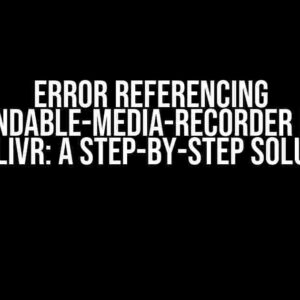Have you ever encountered a situation where you’ve meticulously crafted a jQuery script to switch classes, only to be left scratching your head as nothing seems to work as expected? Fear not, dear developer, for you are not alone. In this article, we’ll delve into the mysterious realm of class switching issues in jQuery, and provide you with a comprehensive guide to identifying and resolving the problem.
Understanding the Basics of Class Switching in jQuery
Before we dive into the depths of debugging, let’s take a brief moment to review the fundamental concepts of class switching in jQuery. The most common methods used for switching classes are:
addClass(): Adds one or more classes to an element.removeClass(): Removes one or more classes from an element.toggleClass(): Toggles one or more classes on an element.
These methods can be used to manipulate the CSS classes applied to an element, allowing you to dynamically change the appearance and behavior of your web page.
Common Causes of the Mystery Issue
Now that we’ve covered the basics, let’s explore some common reasons why your class switching script might not be working as expected:
- Inconsistent Class Names: Ensure that the class names used in your jQuery script match the exact class names defined in your CSS file. A single mismatch can cause the script to fail.
- Multiple Classes with the Same Name: Be cautious when working with multiple classes that share the same name. jQuery might get confused, leading to unpredictable behavior.
- Incorrect Element Selection: Verify that you’re targeting the correct element(s) in your jQuery script. A simple mistake in element selection can render your script ineffective.
- Conflicting Scripts or Plugins: Other scripts or plugins might be interfering with your jQuery script, causing the class switching to malfunction.
- version Conflicts: Ensure that your jQuery version is compatible with the rest of your project’s dependencies and plugins.
Debugging Techniques for the Mystery Issue
Now that we’ve identified some common causes, let’s dive into some practical debugging techniques to help you resolve the mystery issue:
1. Console Logging
console.log() is your best friend when it comes to debugging. Add logs to your script to inspect the element, classes, and script execution:
console.log($("#myElement").attr("class")); // log the current classes
console.log($("#myElement").hasClass(" MyClass")); // check if the element has a specific class2. Inspect the Element
Use the browser’s developer tools to inspect the element and verify that the classes are being added or removed as expected:
| Browser | Shortcut | Action |
| Chrome | F12 | Open DevTools, switch to Elements tab, and inspect the element |
| Firefox | Ctrl + Shift + I (Windows) / Cmd + Opt + I (Mac) | Open DevTools, switch to Inspector tab, and inspect the element |
| Safari | Cmd + Opt + I (Mac) | Open DevTools, switch to Elements tab, and inspect the element |
3. Breakpoints and Step-through Debugging
Set breakpoints in your script and step through the code to identify the exact point of failure:
- In the browser’s developer tools, switch to the Sources or Debugger tab.
- Set a breakpoint on the line where you suspect the issue is occurring.
- Reload the page and step through the code using the debugger’s controls (e.g., F10 or F11).
4. Isolate the Issue
Create a minimal, reproducible example (MRE) to isolate the issue and eliminate external factors:
- Create a new HTML file with only the necessary elements and scripts.
- Replicate the issue in this MRE.
- Share the MRE with others or online communities for assistance.
Solving the Mystery Issue: A Step-by-Step Guide
Now that we’ve covered the basics, common causes, and debugging techniques, let’s walk through a step-by-step guide to resolving the mystery issue:
Step 1: Verify Element Selection
Ensure that you’re targeting the correct element(s) in your jQuery script:
console.log($("#myElement").length); // check if the element is selected correctlyStep 2: Check Class Names and syntax
Verify that the class names used in your jQuery script match the exact class names defined in your CSS file:
console.log($("#myElement").attr("class")); // log the current classes
console.log($("#myElement").hasClass(" MyClass")); // check if the element has a specific classStep 3: Inspect the Element and Classes
Use the browser’s developer tools to inspect the element and verify that the classes are being added or removed as expected:
console.log($("#myElement").attr("class")); // log the current classes
console.log($("#myElement").hasClass(" MyClass")); // check if the element has a specific classStep 4: Isolate Conflicting Scripts or Plugins
Identify and isolate any conflicting scripts or plugins that might be interfering with your jQuery script:
// try disabling other scripts or plugins one by one
// or use a tool like the jQuery Migrate Plugin to identify conflictsStep 5: Verify jQuery Version Compatibility
Ensure that your jQuery version is compatible with the rest of your project’s dependencies and plugins:
console.log(jQuery.fn.jquery); // log the current jQuery versionConclusion
In conclusion, the mystery issue with switching classes in jQuery can be a frustrating experience, but by following the steps outlined in this article, you’ll be well-equipped to identify and resolve the problem. Remember to stay calm, be patient, and systematically work through the debugging process. With persistence and practice, you’ll become a master debugger, and the mystery issue will be a relic of the past.
Happy debugging, and may the code be with you!
Frequently Asked Question
Get answers to the most pressing questions about the mystery issue with switching classes in jQuery!
Why does my jQuery class switching code not work as expected?
This could be due to a variety of reasons, including incorrect syntax, mismatched selectors, or even conflicts with other JavaScript libraries. Double-check your code and make sure you’re using the correct jQuery methods and selectors. If the issue persists, try debugging your code using the browser’s developer tools.
How do I troubleshoot the issue of classes not switching in jQuery?
To troubleshoot this issue, try using the browser’s developer tools to inspect the elements and see if the classes are being added or removed correctly. You can also use the jQuery `hasClass()` and `addClass()` methods to check if the classes are being applied correctly. Additionally, check the jQuery version you’re using, as older versions may have compatibility issues.
What is the difference between the `.addClass()` and `.removeClass()` methods in jQuery?
The `.addClass()` method adds one or more classes to an element, while the `.removeClass()` method removes one or more classes from an element. You can use these methods together to switch classes on an element, for example, `$(“element”).removeClass(“oldClass”).addClass(“newClass”);`.
Can I use the `.toggleClass()` method to switch classes in jQuery?
Yes, you can use the `.toggleClass()` method to switch classes in jQuery. This method adds or removes a class from an element, depending on whether the class is already present. For example, `$(“element”).toggleClass(“active”);` would add the “active” class if it’s not present, and remove it if it is.
How do I animate the switching of classes in jQuery?
To animate the switching of classes in jQuery, you can use the `.addClass()` and `.removeClass()` methods in conjunction with jQuery’s animation methods, such as `.fadeIn()` or `.fadeOut()`. For example, `$(“element”).removeClass(“oldClass”).addClass(“newClass”).fadeIn();` would remove the old class, add the new class, and then fade in the element.



